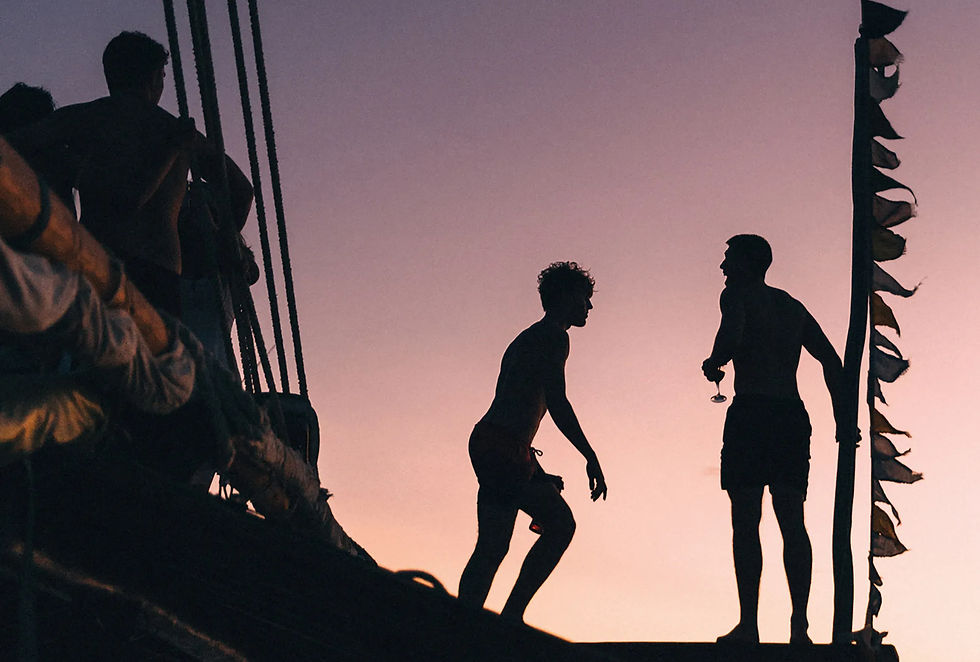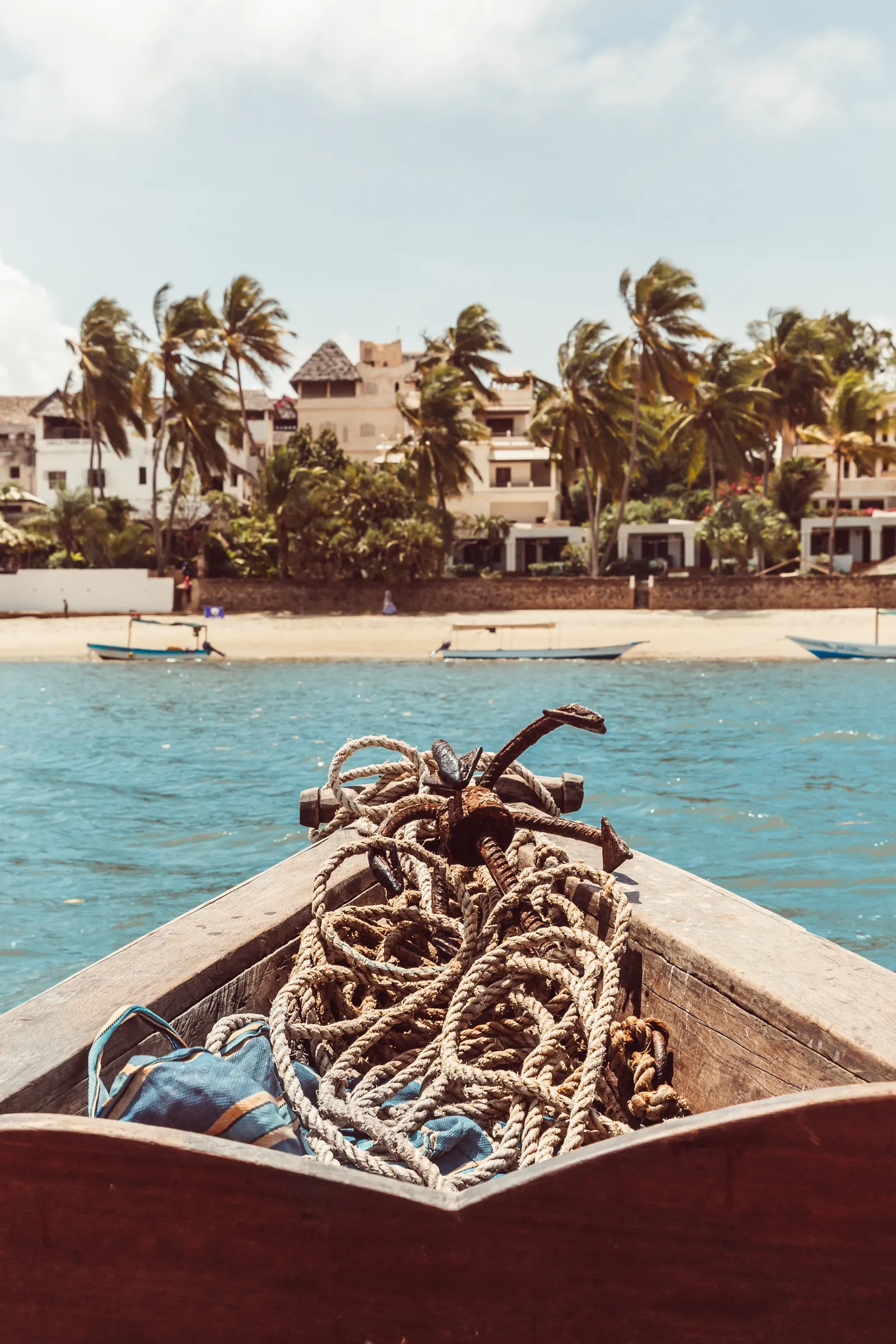Selina Denman charts the story of this part of East Africa—where African, Arab and European influences merge—as well as her own chapter in it.

Photo: Jack Johns

By Selina Denman
In the now faded photo: my mum, demure in an off-white, gold-trimmed sari, hands half-hidden in a swirl of henna; my dad, suit wrinkled, sporting Jackie O sunglasses borrowed from my auntie to block out the Mombasa sun. It's August 4, 1973, their wedding day. I stand in the same spot 50 years later, under the whitewashed arches of Tamarind, then and now “the best seafood restaurant on the whole coast of Kenya,” Mohamed, my taxi driver, tells me categorically. The views from here have not changed much in the last half century. Across the glinting blue of the creek, on Mombasa Island, colonial mansions hide behind a tangle of trees, and the boxy flat-roofed buildings of Old Town, discolored by the salt-laden Indian Ocean air, press up intimately against each other. Wood fishing boats bob in quiet inlets where my parents once spent weekends learning to water-ski.
It was an improbable romance. My father had moved from rural England to Mombasa to seek his fortune; my mother was part of the town's close-knit, conservative Indian Bohra community. They fell in love and somehow convinced my grandparents to allow them to marry. In Swahili, I am nusu-nusu. Half-half. Half-English, half-Kenyan, half-brown, half-white, half-Muslim, half-foreign, half-local. But the story of the Swahili coast has always been one of movement and exchange, of people, stories, and traditions swept along by the tireless trade winds—the steady northeasterly kaskazi; the antithetical, southwesterly kusi; and the transitional matalai.
These winds filled the sails of traders from India, Persia, and Arabia, and later propelled the boats of colonizers from Portugal, Oman, and Great Britain, carrying rice, cotton cloth, new construction techniques, and Islam down the east coast of Africa; sending ivory, spices, gold, and timber, as well as enslaved people, the other way. My parents inadvertently followed those ancient routes, leaving Mombasa for Oman in 1974, detouring up the coast of the Arabian Gulf via Sharjah, Dubai, and Abu Dhabi, and settling in Cyprus in the 1980s. Childhood visits to Kenya were a mission in themselves—three days of connecting flights and interminable transits in Athens, Cairo, and Nairobi before arriving, bleary-eyed and bad-tempered, in Mombasa.
The swimming pool at Dhow House, a private villa rental on Lamu Island. Photo: Owen Tozer, Jack Johns | Peponi Hotel in Shela village has been a Lamu institution since the 1960s. Photo: Owen Tozer, Jack Johns
I fell hopelessly in love with Kenya early on—its freewheeling spirit, infinite beaches, and sprawling national parks—and have returned often. But my mum's Alzheimer's diagnosis has turned her memories into precious, untrustable things, making links to this part of my heritage feel more tenuous than before. Suddenly I am conscious of all the questions I never thought to ask, all the answers I might never hear. So I set off on my own odyssey, from my home in Dubai to Mombasa and Lamu and back again, via Kilifi and Malindi, to try to understand this place that feels at once so foreign and so familiar.
On Mombasa Island, I imagine my mum at Mama Ngina Waterfront Park, named for Kenya's original first lady but known simply as Lighthouse by locals, due to the British-built white behemoth that looms in the distance. Respectable Muslim girls have long come here to promenade, Bridgerton-style, amid hawkers serving muhogo (golden-fried chile- and lemon-covered cassava crisps) and fresh coconuts picked from palms mere feet away. The Likoni ferry departs from around the corner—stocky, sky blue, and laden with pedestrians, cars, buses, bikes, and tourists crossing the Kilindini Harbour into Kwale County and on to the sprawling resorts of Diani on the south coast. Ten minutes away, stoic Fort Jesus is a manifestation of Swahili history. Built as a defensive structure by the Portuguese in the 1590s, it was overtaken by the Omanis in 1698, served as a British prison beginning in the 1890s, was converted into a museum a year before Kenya gained its independence in 1963, and declared a UNESCO World Heritage Site in 2011.

Each of Peponi Hotel’s 29 guest rooms has an ocean view. Photo: Owen Tozer, Jack Johns
When I visit, Ace of Base is blaring from a souvenir shop at the foot of the fort's adamantine walls, a Rorschach-esque composition of original stone and layers of ochre paint. In the elevated central courtyard where soldiers would have once stood watch, a group of children on a school trip are being corralled with a rendition of “If You're Happy and You Know It.” I clap my hands. To one side, views of the open sea—and potential attacks by enemy forces. To the other, Old Town, its buildings crumbling but beautiful. My mum grew up near here, but this part of Mombasa remains a mystery—to me, most tourists, and many residents—shunned in favor of the mainland's leafier Nyali neighborhood or the unending beaches of Bamburi further down the road.
All is quiet on Sir Mbarak Hinawy Road as it leads me away from the fort, past the all-white Mandhry Mosque, built in 1570 but still operational, and shops selling raffia bags, tie-dyed caftans, and, in the dusty, dimly lit Gallery Mashallah, Persian carpets, antique furniture, and brass lamps that wouldn't look out of place in the souks of Cairo or Damascus. This Middle Eastern legacy is imprinted on the Kenyan coast, as ever-present as the jagged cries of Indian crows and the low, incessant rumble of waves hitting the reef more than half a mile out to sea. Arab influences roll off the tongue as part of the Swahili language, drift through the air five times a day with the azan, and skirt the seas in the form of hulking dhows largely unchanged since traders from the north first appeared on these shores. One is the Utamaduni, a particularly impressive specimen at nearly 53 feet, making it one of the largest dhows left in Africa. It is currently being restored in a secluded boatyard on Lamu island, 150 miles up the coast from Mombasa. Badi, one of the master craftsmen responsible for its makeover, helps me up a rickety ladder so I can peer into its cavernous belly, its wood ribs exposed like the skeleton of a gigantic beast.
The Utamaduni shares this stretch of beach with a more modern descendant, Flipflopi Ndogo, the world's first dhow made entirely from recycled plastic. Covered in a decorative mosaic of 30,000 multicolored flip-flops found discarded on Kenya's beaches, Flipflopi Ndogo made its maiden voyage from Lamu to Zanzibar in 2019, stopping at coastal villages along the way to raise awareness of plastic pollution. It is back home now, being improved and reproduced in smaller versions that hopefully will one day be seen by local fishermen as a viable alternative to traditional wood boats.
A local woman on Kiwayu Island in the Lamu archipelago. Photo: Owen Tozer, Jack Johns | On caught- in-time Lamu, boat and donkey are still the only means of getting around the island. Photo: Jack Johns
It's a surprisingly forward-thinking enterprise in a place where time seems otherwise to have stopped entirely. Boat and donkey are the only modes of transport in the Lamu Archipelago, a forgotten cluster of islands where lingering sunsets illuminate gold-tinged sands, verdant mangroves, and blue waters in a swirl of soft, dreamlike light. Few people come to Lamu—two degrees south of the equator, a stone's throw from the Somali border, and at what feels like the edge of the world—without being moved by it. Marcella Anselmetti visited from Italy 35 years ago as a documentary filmmaker and knew that she would be back one day to stay. Under the shade of a 700-year-old baobab, in a tree house on her property on Lamu's Manda Island, she now performs sound baths on weary travelers. I lie on her floor, enveloped in the echoes of drums and gongs, and try to let go. This kind of shedding—of shoes, stress, and any sense of time—is the linchpin of the Lamu experience. At the Peponi Hotel in Shela village, there are no phones, TVs, or air-conditioning in the rooms, but nevertheless guests have been flocking here since it opened in 1967 for the views, exceptional food, and sense of escape. It's the kind of place that provides photocopies of hand-drawn maps to guests, and where owner Carol Korschen, whose mother- and father-in-law founded the then four-room hotel, will drop by at breakfast for a chat.
A trio of Maasai tribesmen is playing soccer on the beach in front of the hotel, their red robes billowing, as I embark on the 10-minute boat ride to Lamu Old Town one morning. In East Africa's oldest Swahili settlement, continuously inhabited for more than 700 years, a matrix of UNESCO-listed buildings line the narrow labyrinthine streets. On Harambee, the main shopping street, crowds gather amid tiny stalls that sell mango chutneys and mabuyu, baobab seeds encased in red sugar syrup. The newly opened Hidden Gallery offers a peek inside traditional homes, built specifically to protect privacy and modesty. Owner Swabir worked in the States for decades before returning to his hometown and transforming a 17th-century house into a café and gallery.
The beach in front of Peponi Hotel. Photo: Owen Tozer, Jack Johns | One of Dhow House’s seven bedrooms.
Photo: Jack Johns
I leave Lamu reluctantly, with the passing thought that maybe I, too, might come back to stay one day. A 20-minute plane ride takes me south to the mainland town of Malindi, where it's the Italians who have left their mark. “Milano due,” Ghadaf, my driver, jokes as we pass Italian-owned hotels and restaurants touting pizzas and young children who shout “Ciao!” from the roadside. Naomi Campbell has a home here, and there's a stylized sheen to the place that's different from Mombasa's endearing shabbiness or Lamu's antiquated otherworldliness. Many of the hotels on the Kenyan coast remain trapped in a 1980s time warp. These are the musty all-inclusives that I remember from my childhood. Most in-the-know travelers opt for private villas and beach cottages, and East African Retreats offers some of the best, including the Palazzo at Jacaranda Beach, midway between Malindi and Watamu. I stop for a night here, roaming nine impeccably designed rooms set around an infinity pool on a bluff that tumbles dramatically to the sea.
Everything is interconnected on the Swahili coast. Kilifi is where Kenya's creatives and remote workers have begun to settle, and the town hums with bohemian nonchalance. “It's down-to-earth and very artistic,” Ophélie Pinguet tells me. “It's a bit hippie, but, at the same time, the creative industry is growing.” The young French Rwandan artist and I are having breakfast at the Food Movement, a collective of restaurants, boutiques, artists' studios, and coworking spaces in the heart of a sisal plantation. She gravitated to Kilifi after graduating from the Sorbonne in Paris, embracing the gentle pace of life which is mirrored in her whimsical abstract paintings.

A beautifully patinaed building in Mombasa’s Old Town. Photo: Getty
Tropical birds flit in the trees. Silky separates and breezy dresses hang invitingly next door at Hamaji. The boutique, whose name translates from coastal Swahili as nomad, was founded by Kenya-born Louise Sommerlatte with the support of the UN-backed Ethical Fashion Initiative. Its sophisticated collections are crafted from natural fibers and upcycled vintage clothing. This season's butter-soft knitwear is spun from silk and organic wool by women in disadvantaged communities on Mount Kenya. Sommerlatte tells me that she is inspired by East Africa, the shades of the landscape, the people, birds, prints. I can't help but feel the same. The colorful chaos of the Kenyan coast—its British street names, Indian-inspired food, Arab boats, multihued mosques, evocative music, and disorderly markets—makes perfect sense to me. Not home, but something like it.
Where to stay
In Mombasa, Tamarind Village offers spacious one-, two- and three-bedroom serviced apartments on the banks of Nyali Creek in the leafy Nyali neighborhood. Elsewhere, private villa rentals are the way to go, and East African Retreats offers a fantastic selection: On Lamu, Dhow House sits on a stretch of beach where boat makers have been building traditional dhows for centuries. The faint sound of their hammering can sometimes be heard from the pool within this charming property, which features seven bedrooms encircled by lush gardens and offers rooftop massages and sea-facing yoga. Beach Palazzo, outside of Malindi, is a destination-wedding dream, with nine impeccably designed bedrooms and a huge pool. Perched high above the Kilifi Harbour, Nderit House has five en suite bedrooms, a stand-alone villa that sleeps two, and a stretch of lawn that rolls toward the horizon before dropping into the sea.
Read the original article on Condé Nast Traveler.






Comentarios